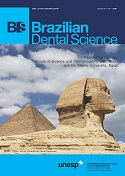Effect of aluminum oxide sandblasting, plasma application and their combination on the bond strength of resin cement to zirconia ceramics
DOI:
https://doi.org/10.14295/bds.2019.v22i2.1721Abstract
Objective: to evaluate the effect of aluminum oxide sandblasting (AOS), argon plasma application (APL) and their combination (AOS+APL) on the shear bond strength (SBS) of dual-cure resin cement (Panavia F 2.0, Kuraray Noritake) to two zirconiabased ceramics (Lava, 3M ESPE and Katana, Kuraray Noritake). Material and Methods: One hundred twenty zirconia plates (13 mm in length X 5 mm in width X 1 mm in thickness) were prepared and treated according to the following treatments: 1- AOS, 2- APL,3- AOS+APL and 4- no treatment (control). After treatments, resin cement cylinders (1.4 mm in diameter x 1 mm in height) bonded to zirconia surface were obtained by filling up the silicon matrix. The shear bond test was performed following storage of the samples for 24 hours and one year. Bond strength values were recorded in MPa and the data were analyzed by three-way ANOVA and Tukey post-hoc test (preset alpha of 0.05). Results: In general, AOS and AOS+APL showed the higher SBS. After one-year storage, SBS of the resin cement to the Katana zirconia did not reduce, regardless of the zirconia surface treatment. Conclusion: AOS alone was able to increase the SBS of the resin cement to both zirconia ceramics compared to control and SBS remained stable after one year depending on type of zirconia ceramic.
Keywords
Aluminum Oxide; Ceramics; Plasma; Resin Cements
Downloads
Downloads
Published
How to Cite
Issue
Section
License
Brazilian Dental Science uses the Creative Commons (CC-BY 4.0) license, thus preserving the integrity of articles in an open access environment. The journal allows the author to retain publishing rights without restrictions.
=================




























